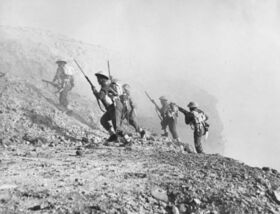Objective R30
This article is incomplete because it is pending further input from participants, or it is a work-in-progress by one author. Please comment on this article's talk page to share your input, comments and questions. Note: To contribute to this article, you may need to seek help from the author(s) of this page. |
| Objective R30 | |||||||
|---|---|---|---|---|---|---|---|
| Part of the Middle East Campaign of the Second Europan War | |||||||
 Troops of the Royal Senchi Rifles charge in Quenminese-Imperial positions near Banzai Hill | |||||||
| |||||||
| Belligerents | |||||||
| Commanders and leaders | |||||||
| Strength | |||||||
|
75,000 troops 100 tanks 150 aircraft 50 guns |
120,000 troops 250 tanks 250 aircraft 75 guns | ||||||
| Casualties and losses | |||||||
| Heavy | Heavy | ||||||
Objective R30 (12 August - 30 August 1942) was a battle that took place in and around the town of Kantabash. The plan largely came from General Alexander Sundermann. It called for Imperial forces to commence a northwestern thrust through Kantabash by means of Route 30 which assured Quang of a fast and hastened encirclement of Sugiyama's forces. But unknown to the Imperials, Sugiyama had already chosen Kantabash to position his defences in the south to prevent a possible encirclement. Primarily consisting of ZANAC forces led by General Leslie Oliver Morshead, ZANAC forces had established strong positions in and around Kantabash.
In August 12, the attack came but Imperial forces were greeted by stiff resistance from the ZANACs, determined to deny the town to Quang. SS Panzer Divisions came into the battle by 18th of August, occupying a 300-metre height known as Gondale Heights. The heights were unoccupied by ZANAC forces and subsequently faced attacks west of Kantabash. The advantage of the heights granted vision across the battlefield for the Imperials, allowing them to commence artillery barrages. This resolved Brigadier Tsukuyo Kushineda to send in raiding groups to destroy enemy installations. Although the raids were a success, Imperial forces had managed to replace damaged instruments and the bombardment resumed by 24 August. Allied defenses were slowly crumbling and the ZANACs took the defences at the streets of Kantabash while the Desert Rats of the Lucian 7th Armoured Division denied the Eastern flank of Kantabash to Duyen.
Eventually, it was decided by Marshal Archibald Sugiyama to capture the hill. He immediately sent in the 5,000-man Royal Senchi Rifles consisting of 5 battalions, along with a handful of raiding units as support. The first attacks came on the 25th of August and the Imperial repeatedly repulsed the Nihhonese battalions from taking the heights. After several repulsed attacks, The Nihhonese Regiment were exhausted, suffering at least 40% of casualties, some low on ammunition. In 29 August, SS and Quenminese troops slightly descended from the heights to attempt to destroy the Nihhonese troops at the base of the heights. By afternoon, the Imperials unleashed a hail of fire. Colonel Saito Nakagawa ordered machine gun squads to counterfire Imperial machine gun positions with snipers countering Imperial sniper fire. With their backs against the wall, men of the 2nd, 3rd, and 5th Regiment of the RSR affixed bayonets or drew their wakazashi charged at Quenminese and Imperial positions on the slopes, screaming Tennōheika Banzai!.
Although the SS and the Quenminese put up a stiff resistance, nothing could stop the Senchi's rushing up the steep slopes, shouting, firing from the hip, and lobbing hand grenades into dugouts. Eyewitness accounts from both sides saw Nihhonese troops stabbing or slashing their bayonets and wakizashi's at Imperial troops. Blood often splattered around the dugouts and in the trenches. Nihhonese Bren gunners often gunned down an entire trench of Imperial troops or fleeing squads. Tommy guns often rattled the slopes that was reminiscent of a Mafia shootout. A witness from the Imperials noted that the Nihhonese charge was like watching a Muon Nam charge only much more scarier. The RSR continued to charge the heights until they reached the other side of the hill by the evening of the same day. The RSR would suffer 3,431 casualties with 291 dead. With the Allies now in control of the hill, the anticipated thrust planned by Quang never took place as the Allies still had control all over the area at Kantabash. This resulted Quang to call off his attack and instead focus his efforts in encircling Sugiyama at Kabul.
The failure of the Imperials to route the Allies at Kantabash significantly altered Imperial plans. Although Sugiyama was still forced to continue the fight in the Nepali Mountains, the latter had managed to force Quang to fight him in the Northern Afghanian lowlands, by which had contributed to a delaying action that saw elements of the 2nd ERUIF to relieve the Allies and force Imperial force out of Afghania at the Khost Pocket, capturing nearly 2/5ths of Imperial forces.